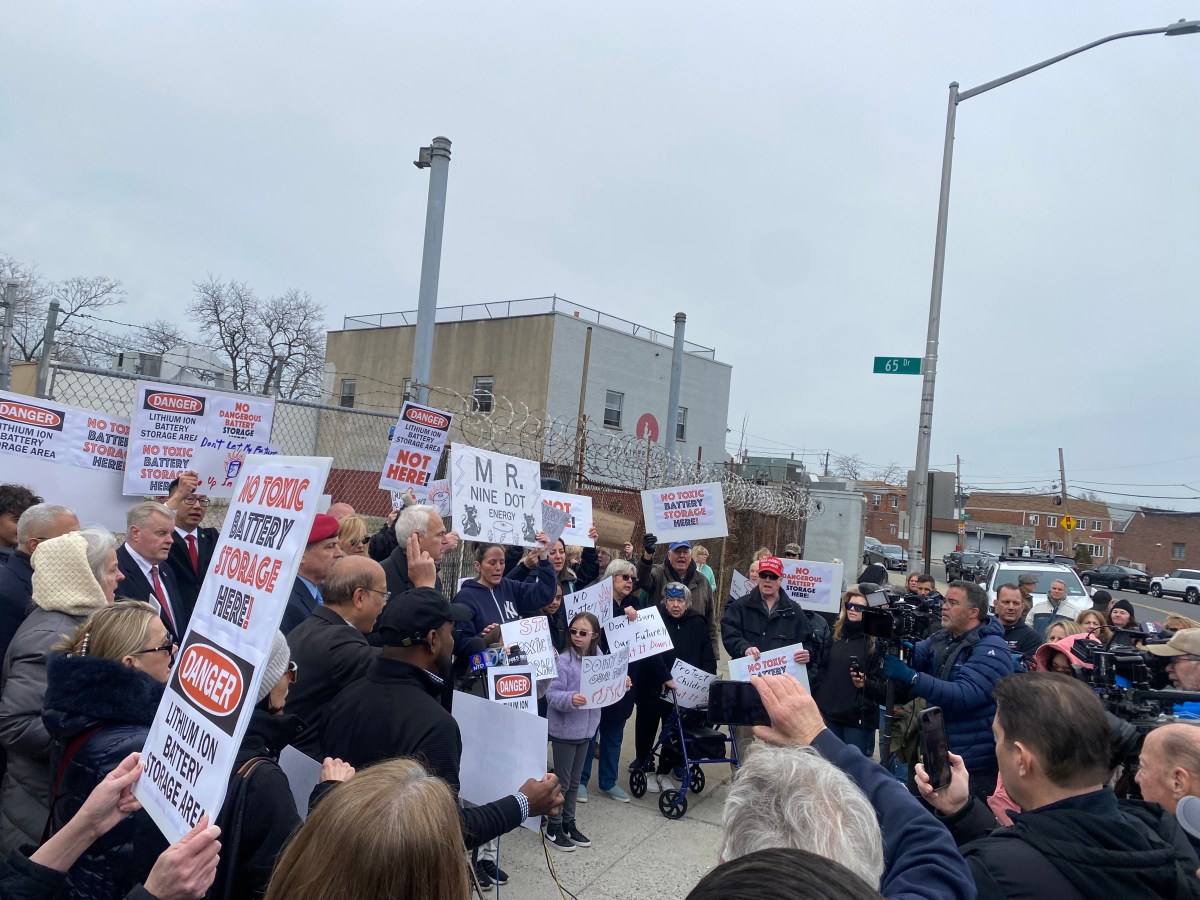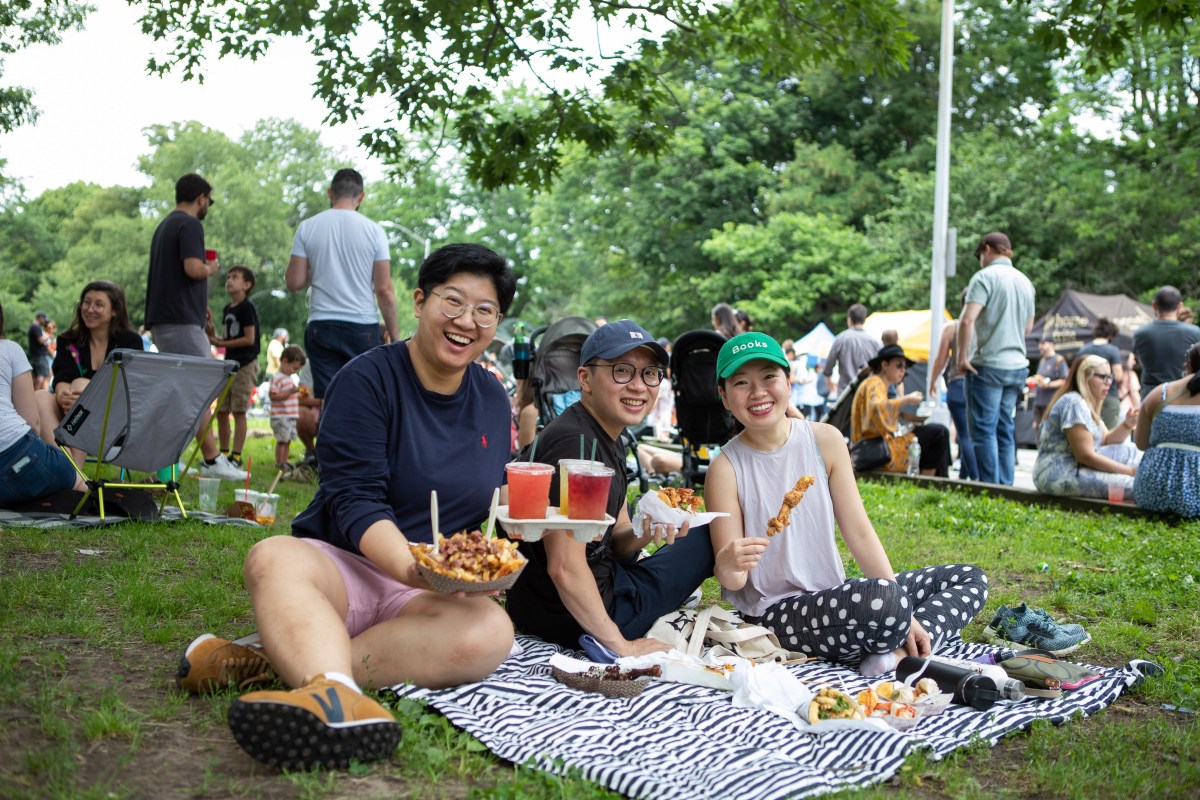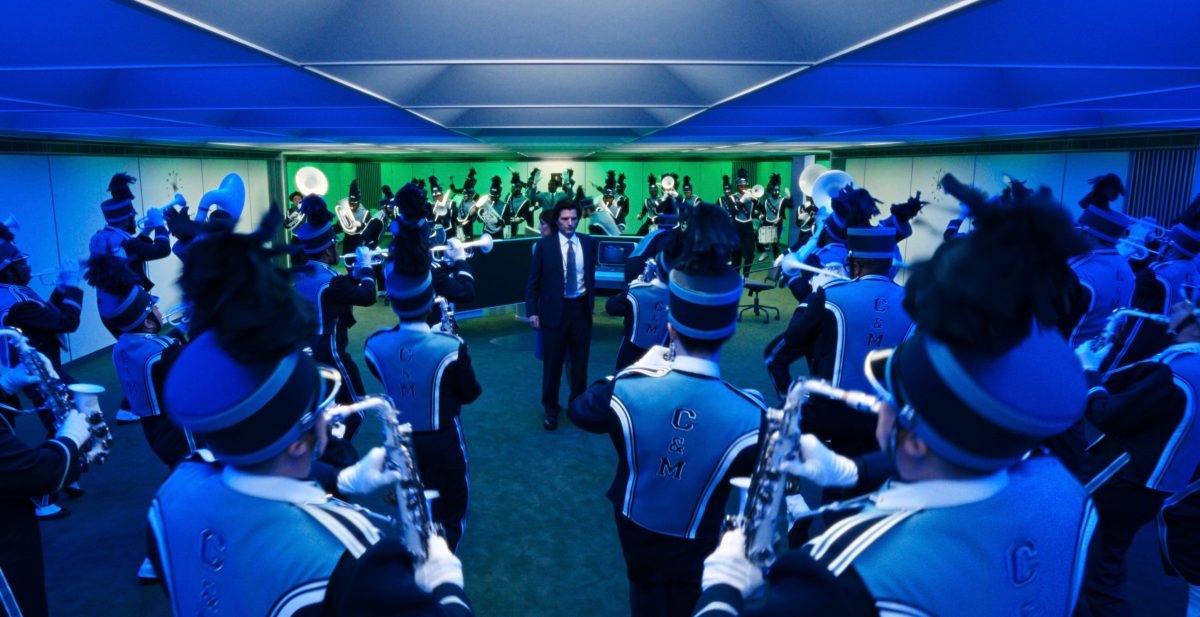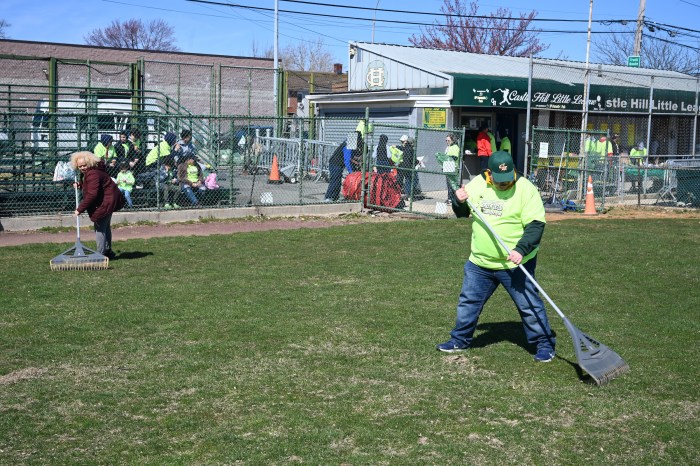By Lincoln Anderson
What’s wrong with W. Eighth St.?
Members of the street’s recently revived block association were hoping for answers to that question when they invited Honi Klein, executive director of the Village Alliance business improvement district, to speak at the their meeting two weeks ago.
As anyone who has recently walked down Eighth St. between Fifth and Sixth Aves. can’t help but notice, the block resembles a retail ghost town, as if the Great Depression had hit all over again. Virtually every other store is vacant, with For Rent signs prominently posted. In all, about 20 stores were empty when a reporter walked the street two weekends ago. On Sixth Ave., the former Sam Goody space, also in the BID’s district, is vacant.
Clearly, it’s a sensitive subject for Klein. Upon arriving at the block association’s May 10 meeting at the Jefferson Market Library, and noticing a reporter from The Villager, Klein told block association co-chairperson Ron Barney that the reporter’s presence was making her “uncomfortable.” Fliers for the meeting — noting all were welcome — had been posted on Eighth St. Nevertheless, Klein said, if The Villager reporter stayed, she would leave. It was the block association’s first meeting with Klein, and they didn’t want her to leave. So the reporter left.
Rick Hill, a founder of the original W. Eighth St. Block Association, also walked out in a show of support for The Villager.
However, a New York Times reporter — apparently unfamiliar to Klein — sat through the meeting taking notes, while a reporter for the New York Sun arrived near the end of the meeting, and standing in the back without opening his notebook, also was not identified as a reporter. Both subsequently wrote articles on the state of W. Eighth St.
At the meeting — as reported to this newspaper afterwards by block association members — and in a subsequent interview with The Villager, Klein outlined the problems as she sees them with W. Eighth St. Namely, in the face of competition, the retail strip can no longer thrive as a one-product shoe store district, the retail spaces are small and the rents are prohibitively high.
“First of all, we had an abundance of shoe stores here for 20 years,” Klein said in the interview. “And no matter where the shopping area is, there’s always a turnover. We had a good run. There is no other block in the BID that had such a concentration of one business.
“We have to find the products or categories that aren’t in our area. You can’t just have one thing that overwhelms the block,” she noted.
Two new shoe stores on 14th St. at Union Square — DSW and Shoe Mania — have drawn away business from Eighth St., Klein said.
Still, she noted, 16 shoe stores remain between Sixth Ave. and University Pl.
On the positive side, Pio Maya is a new eatery at 40 W. Eighth St. Other food shops on the block are doing well, including Le Pain Quotidien and Eva’s restaurant, which are both expanding. And a Belgian waffles place is coming soon.
BID seeks help
The BID has issued a request for proposals seeking a consultant to do a retail analysis of the entire BID area, including Eighth St. from Sixth Ave. to Second Ave. and St. Mark’s Pl., Astor Pl. and three blocks on Sixth Ave. between W. Eighth and W. Fourth Sts. The R.F.P. states the consultant’s fees and costs are to be from $18,000 to $23,000.
The R.F.P. says the consultant is to analyze competing shopping areas to determine the best possible “niche opportunities” for the alliance’s district; develop a strategy for filling vacancies and “attracting upgraded retail tenants;” identify a minimum of 10 prospective retail tenant categories; and determine the potential for creating destination stores.
“Over the past 10 years,” the R.F.P. states, “there has been a steady increase in the number of shoe outlets and novelty gift shops and a decline in destination tenants, such as movie theaters and restaurants. As a result, the reasons to shop on or visit Eighth St. have also declined.
“Another significant factor working against attracting a better mix of businesses,” the R.F.P. continues, “is the average square footage of the retail stores and the asking price per square foot. On average, many of the street-level shops on Eighth St. between Sixth Ave. and St. Mark’s Pl. range in size between 500 square feet and 1,500 square feet with exceptionally few over 3,000 square feet. Kmart at the corner of E. Eighth St. and Fourth Ave. is an exception and occupies 143,000 square feet.”
Prettier hasn’t worked
The alliance undertook a $2.1 million streetscape renovation of Eighth St. from 2001 to 2002. The sidewalks were widened several feet to their 1930s width before the cross-town trolley began operating; 38 historic F lampposts, of the type present in the Village in the 1950s and ’60s, were installed; 60 new trees were planted where there had been none before; and hanging iron flower baskets were added to the lampposts.
“These dramatic improvements…were created to promote and attract new businesses and shoppers to the district,” the R.F.P. states, however, adding, “Unfortunately, there has been little change in the retail inventory, and the number of shoppers has decreased.”
Tony’s Little Gift Shop on Eighth St. near MacDougal St. — which sells women’s party accessories — recently had signs up in its window announcing a 50-percent-off-going-out-of-business sale.
“Yeah, the street is kind of dead now,” said the woman working there the other day. “This shop started two-and-a-half years ago and the business was booming. Before, we could make $2,000 or $3,000 a day on a weekend. Now, it’s like $200 or $300.” She said the store would close in a month or two.
In the window of EXEX next door, among the rebel silver belt buckles was one of Bob Marley smoking a spliff and another with the motto “Elvis — He dared to rock — 1935-1977.”
“It used to be a very good street in the 1990s,” said Sam, the store’s manager. “Up until 2000, it was good. All of a sudden, the traffic went to the East Village — like St. Mark’s.
“This one across the street,” he said, stepping outside his door and pointing to the former Man Plus clothes store. “He’s been here for 20 years. He just went out of business three or four months ago. And the one over there, next to the shoe store — empty for over a year.” Sam said he’d heard some rents for bigger spaces on the block ran as high as $20,000 a month.
‘It’s disappointing’
Norman Buchbinder, of Buchbinder & Warren, a major property owner on the street, founded the BID and is its president emeritus. He noted he appointed Klein as the BID’s director when it formed in 1993.
“I think she tried, but it’s been disappointing,” he said of the W. Eighth St. situation. “They tried to do a lot of things but it’s been disappointing. I do think what will help is to diversify the type of tenancy. It’s been known as the shoe block. Unfortunately, Honi has not come up with any new ideas, except to hire a consultant who will take three months to analyze it…. I hate to say it, but who do you blame? You blame the boss,” he said of Klein.
Recalling there used to be fashion shows on Eighth St., Buchbinder said, “I don’t think she’s tried to do anything like that in the last couple of years — what happened to the fashion shows? Maybe we can get, what’s his name, [David] Blaine to do something there.”
W. Eighth St.’s stores are indeed small, yet, Buchbinder noted, Bleecker St., which also has small stores, has succeeded with high-end fashion. Meanwhile, Lower Broadway has siphoned off shopping from W. Eighth St.
Buchbinder said his realty firm has had to lower its rents to keep and attract tenants on W. Eighth St.
New tenants Buchbinder has coming into his commercial spaces include a liquor store, a wine store, a wine bar, a Japanese cupcake shop, the Belgian waffle place — and he has retained a futon store by lowering its rent.
“We feel you have to work with these people to help build back Eighth St.,” he said. “So we lowered our rent considerably. We’re trying not to rent to the jewelry stores, and definitely not the shoe stores.”
Gil Horowitz, co-president of the Washington Square/Lower Fifth Ave. Block Association, said he and block association members walked on Bleecker St. a few days after the meeting with Klein to try to understand why that street is succeeding.
“We are the orphan. We are the stepchild of the entire neighborhood,” Horowitz complained. “And there is no reason for that to be. W. Eighth St. once was an exciting hub — a gateway to the Village. Today it looks like a blighted area. Nobody wants to come to an area that looks like a blighted area.”
Horowitz said W. Eighth St. needs vision, but, he said of Klein, “In my opinion, she’s not a visionary marketer.”
“I don’t think she has the sense of urgency we do,” he added. “We live there.”
Who buys this stuff?
Carol Wilson, W. Eighth St. Block Association co-chairperson, is still waiting to return home after her apartment was literally pulled apart after the recent unsettling incident where mercury was mysteriously found in it. But she’s also disturbed about the retail situation on W. Eighth St., where she says the stores don’t offer anything anybody living on the block wants.
“Most of it’s now club clothing, tattoo stuff, smoking apparatus, belt buckles,” she said. “We don’t shop there. I don’t think N.Y.U. students even shop there. People are shopping at discount shoe stores on 14th St., and look at the shoes they sell here — high-heeled, with sequins. Who wears those?”
Sharon Woolums, another block resident, is suggesting using a color scheme for the block, like in South Beach, Florida, where the buildings are painted pink and pastel colors. Except on Eighth St. it would be based on the earth tone of the facade of the New York Studio School of Painting and Sculpture, the former Whitney Museum, at 8 W. Eighth St.
LindaAnn Loschiavo, who lives on Ninth St. and has studied the history of the area, said the street used to have many destination businesses, some of which used to get regular write-ups in the newspapers. In the early half of the last century, Eighth St. had two premier restaurants, Gonfarone’s and SeaFare. Later, the block had nightclubs like Bon Soir, where Barbra Streisand debuted.
“The big thing that I feel hurt Eighth St. was the stopping of these listings and media attention and regular publicity of things happening on the street,” Loschiavo said.
Meanwhile, Klein seems to be focusing her attention elsewhere, Loschiavo pointed out.
“Honi Klein has Taste of the Village — and it’s not even on Eighth St. It’s in Washington Square Park,” Loschiavo said, referring to the food-tasting benefit, held under a white tent in Washington Square, that has raised tens of thousands of dollars for the park.
But Klein defended her focus on Washington Square Park — which is not in the Village Alliance’s BID area — saying, “One thing has nothing to do with the other. But I think that the park being an attractive place where people want to stroll is only 300 feet away. That is the [area’s] primary destination,” she said of the park. She said nothing happened to the fashion shows, but that they were interrupted when the BID was renovating the street.
Wilson also feels the motorcyclists who come to the block and park and hang out by Gray’s Papaya make the street less attractive.
“We have a No Stopping sign on the street for after 11 o’clock at night, and nobody stops and nobody enforces it,” Wilson charged. “I’m sure they’re there to stay and that’s unfortunate,” she said of the 24-hour papaya place.
It’s not crime
Crime on W. Eighth St. is not a problem, though, according to Detective Mike Singer, Sixth Precinct community affairs officer, who remembers patrolling there back in the 1980s when he was a beat officer.
“In the ’80s, there was a serious crime problem on the block,” Singer said. “There used to be front breaks all the time. People would steal whatever they could. If they could steal one shoe, they would. The problems today are traffic, parking, motorcycles and loud radios in cars.”
Told some are saying more vision is needed to revive W. Eighth St. and restore it as the Village’s premier shopping street — as it was in its heyday — Klein bristled.
“I don’t know what that means,” she said. “The renovation of the sidewalks was vision…. Painting the buildings pink? I don’t know what you mean.”
She then faxed over a list detailing the streetscape improvements from 2001 and 2002.



































